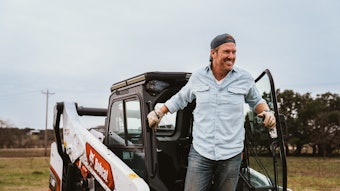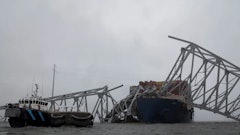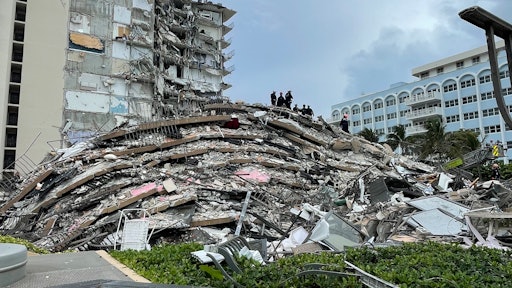
In the early hours of June 24, 2021, Chris Willford woke up to the devastating news that a condo building in Surfside, Florida, had partially collapsed. He immediately knew how unprecedented such a collapse was, and his first thought was, “How can we help?” By “we,” Willford meant the demolition company he founded, Pompano Beach, Florida-based Alpha Wrecking.
“I knew right away that a good demolition contractor needed to get involved,” Willford says. “Because the secondary tragedy could be somebody with the wrong equipment, the wrong tools and the wrong experience going out there and compounding the error. As a responsible demolition contractor with 40 years in the business, one of the main ways we could help would be to bring demolition experience and expertise to bear on the situation.”
The company’s safety director, Mike Obrakta, was only about a mile away from Surfside that morning, so Willford asked him to head to the site and see how Alpha might be able to assist.
Obrakta assessed the situation, came up with a plan and showed it to John Rojas from Miami Dade Fire Rescue, who was leading one of the task force teams set up by the Federal Emergency Management Agency (FEMA). By noon, Willford had made it to the site himself.
Quick mobilization
“John Rojas actually called me on the way down because he knew I was coming,” Willford says. “His question was, ‘I’ve seen your equipment; how quickly could you get it here?’ I said that if he told me right now to start moving it, we’d have equipment there in four hours and would be fully mobilized within eight to 10 hours.”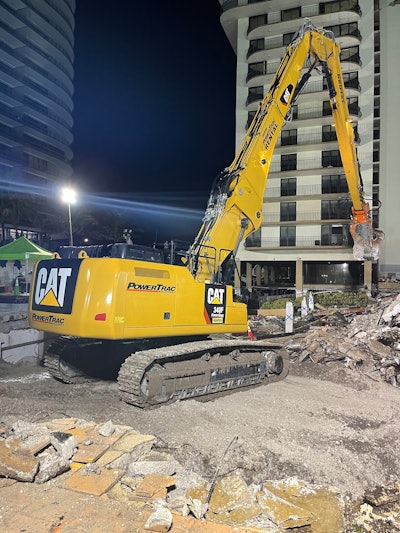 National Demolition Assoc.
National Demolition Assoc.
By 4:30 p.m., Alpha had been authorized to move in equipment. Before sundown, the company delivered two Cat 336 excavators with thumbs, a 150-foot boom lift, a Volvo 480 high-reach excavator, a Cat 938 rubber tire loader and two Cat skid steers.
The first task was to clear the road leading into the site, which was full of debris and damaged cars. After that, the crews created a staging area between the start of the beach and the edge of the pool deck and parking garage structure where material from the collapsed Champlain Towers South building could be placed.
“We had set ourselves up on 88th Street facing south into the pile, but we realized we had to set up an identical, separate operation on the south side of the collapsed building facing north so we [could] pull material at all times from both sides,” Willford says.
A team effort
Willford knew that in order to double up operations, he needed more equipment. That’s when Ryan Udelson got involved. Udelson is vice president of PowerTrac Machinery, which was able to provide a Cat 340F high-reach excavator equipped with a Fortress FC25R concrete processor, Cat 390 excavator and several other pieces of equipment, to Alpha. Helping out was a no-brainer for Udelson, who lives 10 minutes from Surfside and knows people who resided in the building.
“We knew what a critical role our machines would play in the search and rescue efforts. I am grateful we had the equipment on hand, and proud of our team for coming together and making sure it was delivered quickly and ready to perform around the clock,” Udelson says. “And watching our machines in the hands of Alpha … it was incredible to watch them work with such precision under such stressful conditions.”
Alpha crews worked 24 hours a day, seven days a week for 18 days, ultimately taking the 50-foot pile down to street level.
On-the-fly solutions
Throughout the process, because of the scrutiny inherent in such a public disaster, Alpha had to explain its means and methods – why it was doing things the way it was doing them – both to on-site religious community leaders who were skeptical of using heavy machinery during a sensitive recovery mission and members of FEMA’s task forces who weren’t as experienced with demolition equipment and processes. Willford says he had to “turn people into believers.”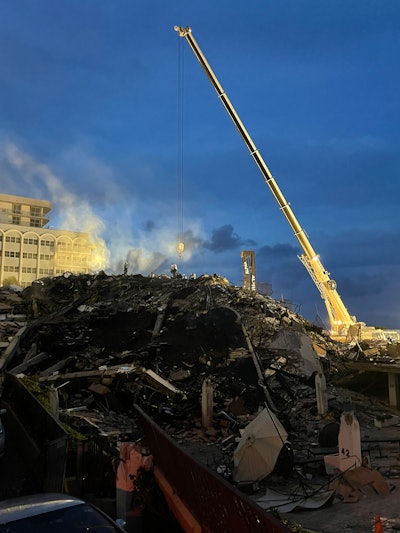 National Demolition Assoc.
National Demolition Assoc.
At one point, Alpha asked one of the task force leaders if it would help them if he could free up some of their workers. Willford explains, “I said, ‘You see that Lull right there? I can have the operator bring it right here, put his wheels on the curb, blow out with the forks all the way up to the four or five guys who are standing on the pile, and we’ll get all that debris down with that piece of equipment, and you can send those guys who are passing down buckets to do something else.’”
That action alone freed up 15 to 20 fire rescue people to do something more productive than “juggling buckets up and down” the pile, Willford says. And that’s just one example of how Alpha’s expertise impacted the operation. “On the fly, we were establishing procedures and means and methods about how to bring our demolition experience to bear on the tragedy,” he says.
Willford continues, “Toward the end of the process, one of the task force directors took me aside and said, ‘As far as we’re concerned, Alpha is as much of a first responder as any of us. In fact, if it weren’t for you guys, and the means and methods you brought to bear on the circumstances, that pile would still be 35 feet tall.’”
Decision to implode
Mark Loizeaux also woke up on the morning of the collapse with an imperative. His company, Controlled Demolition Inc. (CDI), was contacted by the state of Florida at 10 a.m., and Loizeaux arrived to the site by 5 p.m.
“After reviewing the available structural plans, the condition of the structure, the concerns that FEMA and Urban Search & Rescue engineers had for the safety of their personnel, and the risk to possible survivors trapped in the historic debris, I advised state representatives that I thought CDI could bring the remainder of the structure down – with minimal preparations over a two-day period – without having new debris disturb or land on the historic debris or putting sensitive utilities under Collins Avenue at undue risk,” he says. “The evening of July 2, 2021, I was given a notice to proceed with that plan.”
Conventional demolition methods would have proved too risky and taken too long; implosion was the only way to safely allow search and rescue operations to address the entire debris pile. “Our preparation and explosives loading operations took less than 18 working hours, which minimized the duration of worker exposure to identified risks,” Loizeaux says.
The implosion occurred at around 10:30 p.m. on July 4; the search for survivors continued shortly after.
The role of demolition
In emergency situations like the Surfside condo collapse, agencies such as FEMA quickly mobilize and provide engineering expertise and resource management, but they don’t necessarily have expertise in “failed structural systems that have not yet fallen,” Loizeaux says.
“Demolition contractors who make a regular practice of modifying structural systems during the demolition process have a wealth of knowledge and experience that FEMA and stakeholders can draw on under emergency circumstances,” he continues. “Those demolition contractors who are experienced in dealing with compromised systems have a perspective that looks at the damaged structures in a different light, often providing solutions or at least paths forward that elude standard engineering practices.”
Without experts like Alpha Wrecking, PowerTrac Machinery and CDI on the scene, an already tragic situation can quickly become worse. This is one of the reasons why the National Demolition Association exists: to ensure all demolition contractors are able to be first responders if the need arises, and to illustrate to the larger public the importance of the demolition industry.
“One the primary functions of NDA is to educate its members, the construction industry and society as a whole about the demolition industry,” says NDA Board of Directors Member Steve Schwarz. “NDA has worked very hard over the last five years in developing the Foundations of Demolition Courses that stress safety, proper planning, management, etc. The key now is to get those people who manage such emergency situations to learn about our industry. It is difficult and costly (both financially and safety wise) to learn during such operations. We are currently working on a program to educate such individuals so, if nothing else, they know where to turn for help. Who else is better prepared to respond to disaster such as this? Demolition contractors have the equipment, personnel and knowledge on how buildings collapse and how to clean up a mess better than any other trade.”
Ultimately, 98 people were confirmed dead in the Surfside condo collapse, making it one of the deadliest structural engineering failures in U.S. history. You can’t prepare for the inconceivable, Shwarz says. “All you can do as a contractor is run a good demolition operation that stresses safety, proper management and maintaining your equipment so it is ready on a moment’s notice. You must be prepared to respond.”

